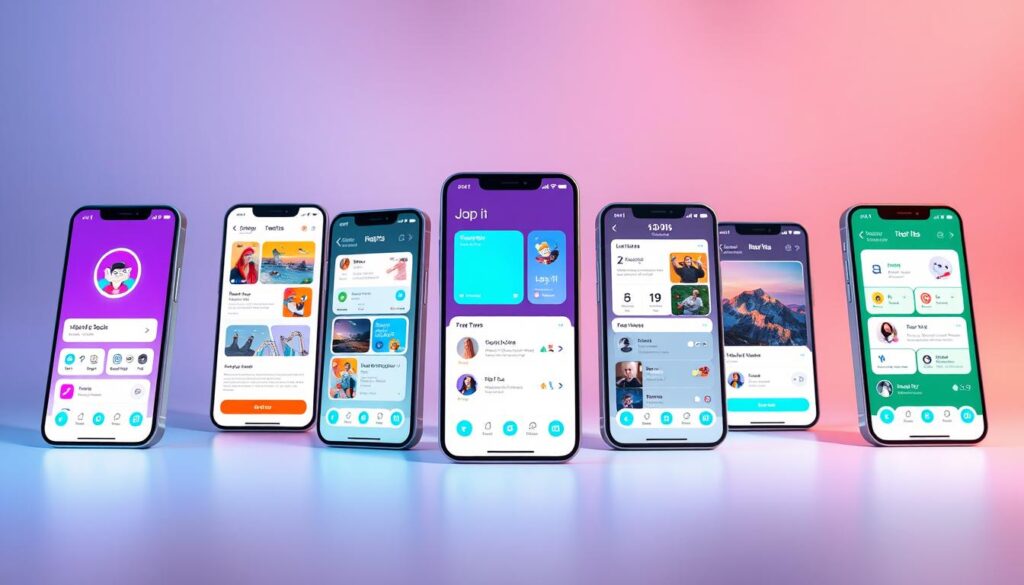“Innovation distinguishes between a leader and a follower.” — Steve Jobs
In today’s fast-paced digital world, creating a successful app development business can be incredibly rewarding. With over 5 billion smartphone users globally, the demand for mobile applications continues to soar. Whether you’re building a startup, freelancing, or enhancing an existing business, the opportunities in this field are vast.
The journey can begin in various ways: learning to code, using app builders, or leveraging white-label services. Platforms like Team Treehouse and Code Academy offer valuable resources for those eager to learn. Remember, starting with passion and a clear objective is key to navigating this dynamic industry.
This guide will explore the essential steps and strategies to help you get started. From understanding the development process to monetization models, we’ll cover what you need to know to succeed in this exciting field.
Key Takeaways
- The global app market is growing rapidly, with a projected value of USD 755.50 billion by 2027.
- There are multiple paths to enter the industry, including learning to code, using app builders, or white-label services.
- Understanding your target audience and their needs is crucial for creating successful applications.
- Monetization strategies include paid apps, freemium models, subscriptions, and in-app purchases.
- Starting with a clear vision and passion is essential for long-term success in app development.
Understanding the Mobile App Landscape
The mobile app industry is thriving, with the global market projected to reach $407.31 billion by 2026. This growth presents immense opportunities for businesses and developers alike. As of 2023, the Google Play Store hosts over 2.87 million apps, while the Apple App Store features around 1.96 million, showcasing the vast potential for innovation.
Exploring Market Trends and Opportunities
Android dominates with a larger market share, appealing to a broader audience, while iOS focuses on a niche market with high retention rates. Developers often choose Android for its widespread reach and iOS for its loyal user base. Hybrid solutions, like React Native, offer cross-platform compatibility, reducing development time and costs.
Key Industry Challenges and Advantages
Despite opportunities, challenges like platform limitations and competition exist. Android offers flexibility but requires more testing due to diverse devices. iOS, while streamlined, has stricter guidelines. Hybrid apps balance ease and functionality but may lack native performance. Understanding these dynamics helps developers make informed choices.
As the industry evolves, staying updated on trends and technologies is crucial. Whether you’re a seasoned developer or just starting, the mobile app landscape offers endless possibilities for growth and innovation.
Essential Tips for Successful App Development
Creating a successful mobile application involves a mix of skills, tools, and strategies. Whether you’re building from scratch or using existing platforms, understanding your options is key to achieving your goals.
Learning to Code and Build from Scratch
For those who enjoy hands-on work, learning to code offers full control over the development process. Platforms like Team Treehouse and Code Academy provide excellent resources to get started. Coding allows you to create custom features and tailor the app to specific needs, which can be particularly beneficial for unique projects. However, it requires a significant time investment and a steep learning curve, especially for complex applications.
Utilizing App Builders and White Labeling Services
If coding isn’t your strength, app builders like BuildFire offer templates and drag-and-drop tools to simplify the process. These platforms enable rapid app deployment without extensive coding knowledge. White labeling services are another option, allowing you to brand pre-built applications as your own. This method is ideal for quick launches and can be cost-effective, though it may limit customization compared to building from scratch.

Both methods have their pros and cons. Coding provides flexibility but demands more time and skill, while app builders offer speed but less customization. Consider your business goals and resources when choosing the approach that best fits your needs. For more insights on essential tools, visit this resource to explore further.
Navigating Business Considerations and Costs
Starting an app development business requires careful financial planning. Budgeting is crucial, with typical costs ranging from $250,000 to $500,000. Understanding where to allocate resources is key to success.
Budgeting for Design, Security, and Development
Allocate funds wisely across design, security, and development. Design and security are often overlooked but are vital for a seamless user experience and data protection. Development costs vary based on complexity and platform choice.
Choosing the Right Monetization Strategy
Explore strategies like freemium models or in-app purchases. Each approach has pros and cons. For insights on tools and strategies, visit this resource.
Clear business targets help avoid overspending. Plan for long-term growth with strategic cost management to ensure sustainability and success in the competitive market.
Enhancing User Experience and Mobile Interface Design
A well-crafted mobile interface is the backbone of any successful application. It’s not just about looking good—it’s about creating an experience that keeps users engaged and coming back for more.
Designing for Touch and Streamlined Navigation
When designing for mobile, every element should cater to touch interactions. Buttons need to be large enough to tap easily, and gestures should feel intuitive. For example, swiping left or right should have a clear purpose, making navigation seamless. Spacing is also crucial—cluttered screens can frustrate users and drive them away.
Streamlined navigation is key to retaining users. A study by Google found that 79% of users will abandon an app if it’s difficult to use. Simple, intuitive designs ensure that users can find what they’re looking for without hassle.
Integrating APIs, Cloud Services, and Plugins
Adding advanced features doesn’t have to mean complicating your app. APIs and cloud services, like those from IBM Cloud, can enhance functionality without overwhelming the device. For instance, integrating a payment gateway API can simplify transactions, while cloud services can handle data storage and processing in the background.
Plugins and third-party libraries are another way to boost functionality. They can add features like social sharing or analytics without requiring extensive coding. This approach keeps your app lightweight and focused on what matters most to your users.

Remember, a great user interface directly impacts your business success. By focusing on touch-optimized designs, integrating powerful services, and keeping your interface clean, you can create an app that stands out and keeps users engaged. For more tips on improving your app’s user experience, check out this resource.
Wrapping Up Your App Development Venture
Embarking on an app development journey can be both exciting and challenging. As you conclude this guide, remember that success in this dynamic field requires a clear vision, strategic planning, and a commitment to continuous learning.
Your path to building a successful mobile application depends on your business goals and resources. Whether you choose to code from scratch, use app builders, or opt for a hybrid approach, aligning your strategy with your objectives is key. Consider your target audience, budget, and the user experience you aim to deliver. Practical advice, such as prioritizing security and integrating advanced features, will help you navigate both technical and business challenges.
Stay focused on innovation and user-centric design. With careful planning and a commitment to learning, you can overcome obstacles and achieve your goals. Take the next step today and turn your vision into a thriving mobile application that stands out in the competitive market.








